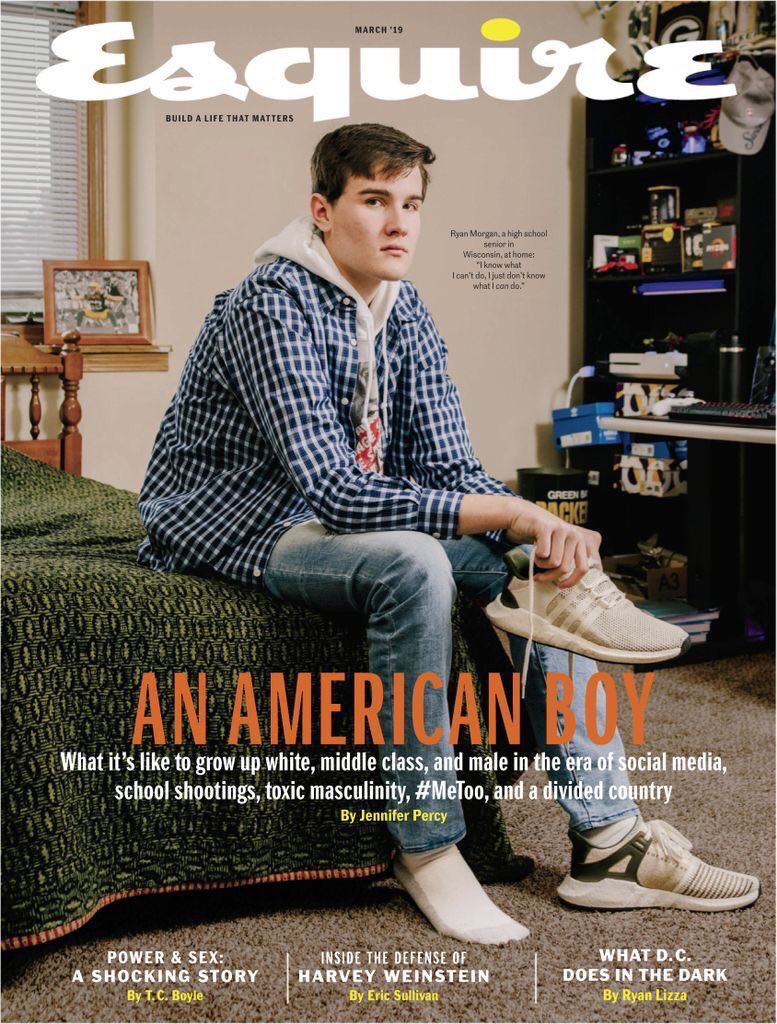
Ryan Morgan is a 17-year-old, high schooler who lives in West Bend, a small Wisconsin town with a population of thirty thousand. Like many other Midwestern kids, he likes hunting deer, playing Call of Duty, and hanging out with friends. He’s also on the cover of this month’s Esquire, not in spite of his averageness, but because of it. In the first of what will be a series of profiles on American teens, this story promises to unpack “what it’s like to grow up white, middle class, and male in the era of social media, school shootings, toxic masculinity, #MeToo, and a divided country.”
Much of the story delves into the more mundane parts of Morgan’s life — he wakes up at 5:30 AM to go to school, wonders why he needs to take English Comp, and thinks about what he wants to do with his life. The real reason he’s on the cover, however, is the fact that he’s a white male who likes Donald Trump, something he feels has unfairly made him a target in today’s political climate. “Last year was really bad,” he’s quoted as saying. “I couldn’t say anything without pissing someone off. Everyone hates me because I support Trump? I couldn’t debate anyone without being shut down and called names.”
In a letter to his readers, Esquire’s Editor-in-Chief Jay Fielden says this is his attempt to get people out of their information silos. “These days, most of us have splintered off into our own ideological echo chambers, regurgitating the talking points of Fox or CNN or MSNBC,” he writes. “Add to this the passions and change this moment has unleashed — MeToo, gender fluidity, Black Lives Matter, ‘check your privilege,’ and #TheFutureIsFemale — and the task of grappling with the world has to be more complicated for kids than it’s ever been.” Fielden wants to give us an up-close and personal view of what it’s like to be a conservative white male in today’s America, a story he feels isn’t represented enough.
That, of course, has garnered a lot of backlash. Many feel this is not only a story that’s often told, but it’s another example of how the media privileges already-dominant voices. The New York Times, for example, often gets criticized for its rehashed profiles on the average red-state voter and how conservative-leaning Heartlanders feel uneasy in a changing social order. Many feel like they don’t know how they’re supposed to behave anymore without offending anyone. Morgan echoes the same frustrations when he says, “I know what I can’t do, I just don’t know what I can do.”
Some have also criticized Esquire for its timing. This is technically the cover of their March issue, but because of how publications work, it hits stands during Black History Month. Many on social media feel the cover is tone deaf at worst, clumsy at best. Monica Hesse at The Chicago Tribune goes a step further, noting that — while Esquire plans to profile black, female, and LGBTQ teens in the future — starting with this one reinforces the idea that white males are the default for what it means to be an American, the standard which others are judged against. “The problem isn’t that Esquire wrote a story about Morgan,” she wrote. “The problem is that it presented the story using a rapidly outdated way of thinking: that white men are the default model. That the #MeToo movement can be seen as a metaphorical assault on white male identity rather than women’s attempt to avoid being literally assaulted.”
Plenty has already been written about Esquire’s cover story (see The New York Times, Salon, and The Guardian, to name a few). Most of them revolve around how we talk about race, gender, and privilege in today’s society, which are beyond the scope of Put This On. On a more clothing related topic, I think Esquire’s cover reveals something deeper about the state of men’s style publishing — and how two very different men are reshaping the two biggest titles.
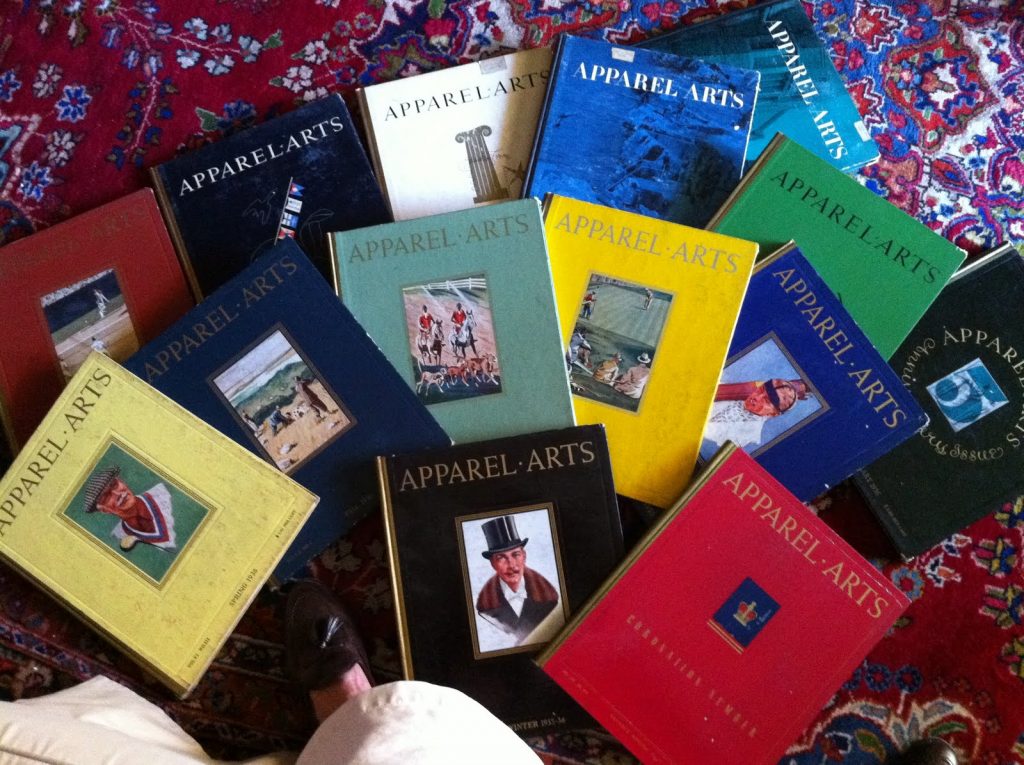
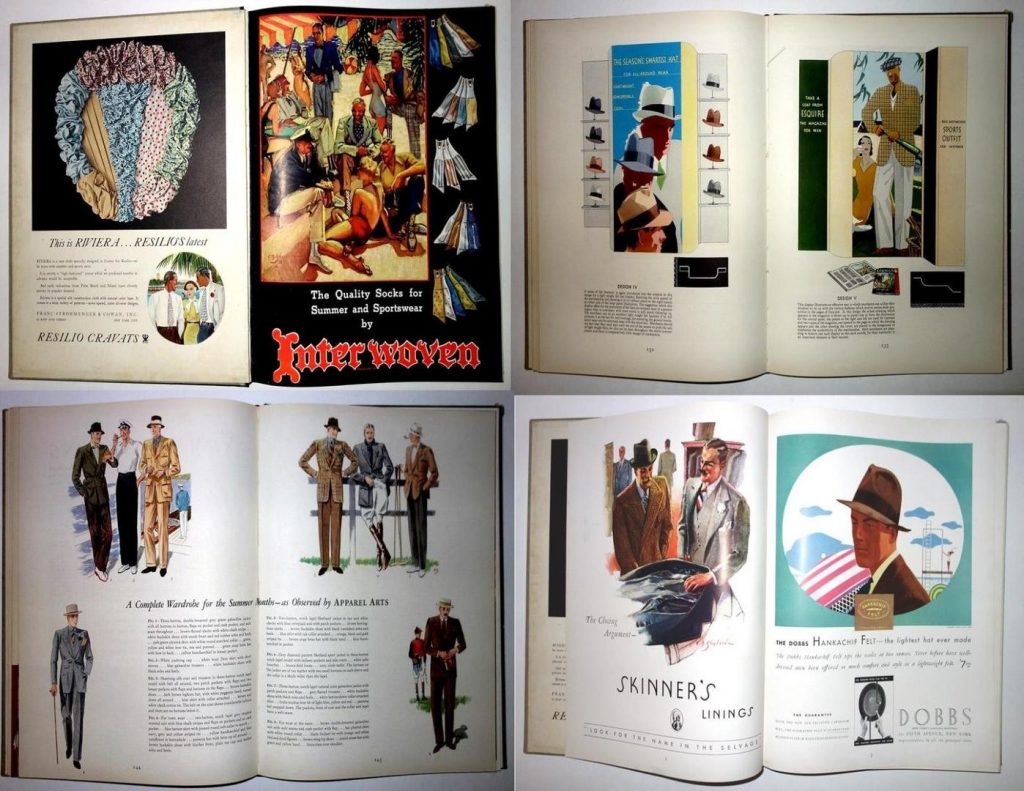
The Beginning of Men’s Publishing
For those who are just getting interested in men’s style, the media landscape today can be disorientating. There are hundreds of blogs, podcasts, forums, YouTube channels, and niche publications dedicated to everything from classic men’s style to the avant-garde. You can learn the basics of how to dress or delve deep into the worlds of techwear, Japanese Americana, the arte povera look, hyped streetwear, and bespoke Italian tailoring.
Things weren’t always like this. In the 1930s, there was just one main title: Apparel Arts. It was a large format, quarterly publication aimed at helping haberdashers give advice to their customers. Instead of talking about the latest brands, they’d run through how a man might want to dress for different occasions. A midnight navy, double-breasted shawl collar dinner jacket, for example, was to be worn in the evening; an open-front beach shirt made from a cotton-silk mixture was for the resort. From the Riveria to clubhouses, campuses to high-rise offices, Apparel Arts gave men instructions for how they should dress for different seasons and settings.
Although Apparel Arts was initially aimed at people in the clothing trade, shoppers eventually got a hold of the publication through sales associates — and they loved it. Due to the positive response, the publication’s founder, Arnold Gingrich, started another periodical called Esquire. Apparel Arts continued as a trade publication, but Esquire was for the public. For a variety of reasons, however, Apparel Arts’ usefulness waned after the Second World War. So it too eventually became a public magazine. In 1957, it was renamed as Gentlemen’s Quarterly (and later, more simply, GQ). This is how we got today’s two biggest men’s style publications, both offshoots of a now little-known trade mag.
Esquire is ostensibly about men’s clothing and style, but it’s really a general interest publication for and about men. Its stable of writers over the years reads like a Who’s Who of 20th-century literature. Their writers over the years include F. Scott Fitzgerald, William Faulkner, Ernest Hemmingway, Joan Didion, John Steinbeck, Dorothy Parker, Tennesse Williams, Sinclair Lewis, Vladimir Nabokov, James Baldwin, Truman Capote, John Updike, and Phillip Roth. These people wrote about much more than clothes; they wrote about politics, society, and adventure.
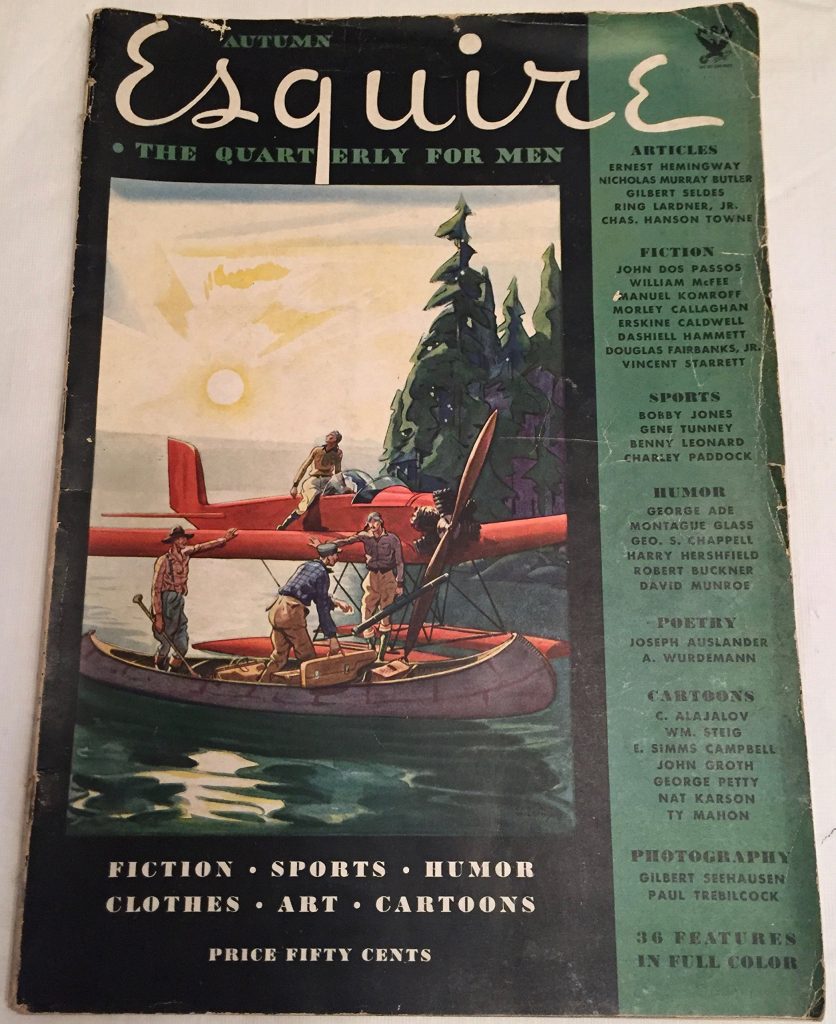
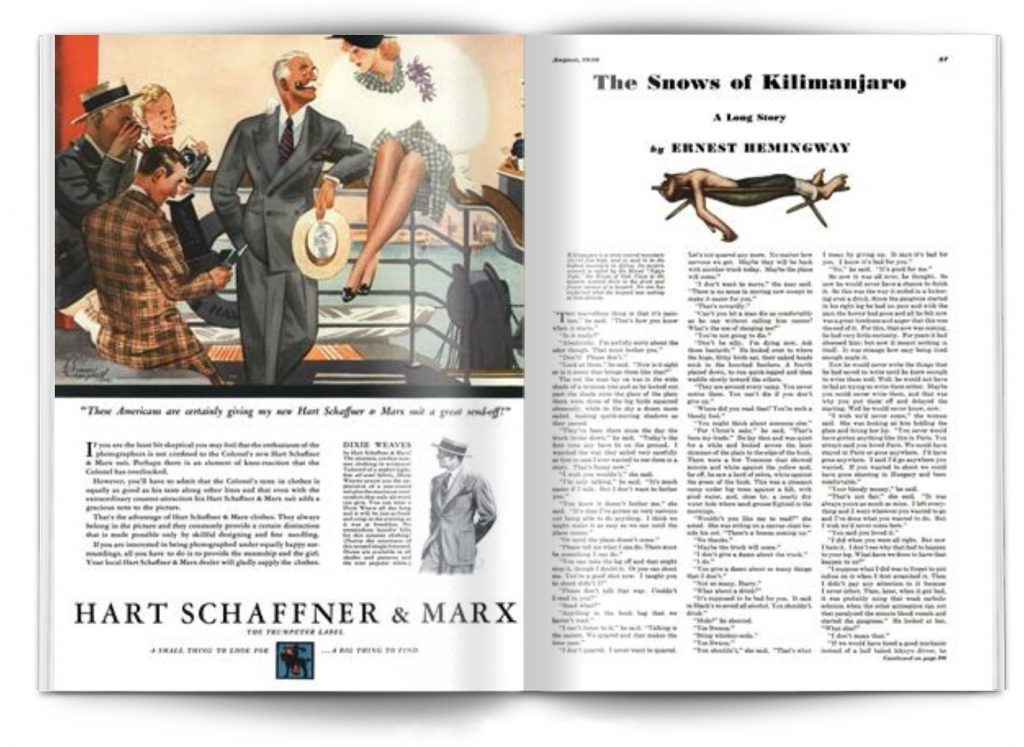
There’s that famous story, for example, of how Ernest Hemingway came to write for Esquire. Gingrich was out fly-fishing and drinking beer with Hemingway when he tried to persuade him to submit a story for one of Esquire’s first issues. Hemingway was proving difficult, but willing to make a deal. If Gingrich could shoot down more beer cans than him with a rifle, he’d pen something. Despite never having even held a gun before, Gingrich was up for the task — and he won. “I guess he was drunker than I was,” Gingrich explained later. Hemingway ended up working as a regular columnist for the publication. One of his greatest works, “The Snows of Kilimanjaro,” was first published in a 1936 issue of Esquire.
It’s hard to overstate Esquire’s influence. They helped spread a very specific look — East Coast, WASP, and slightly upper crust — across the United States. Penny loafers, for example, first became popular when they appeared in the magazine (formerly, they were brought over to the US by Bass, who in turn took inspiration from the kind of shoes worn by Norwegian fishermen, hence the name Weejun).
Esquire also helped draft the template for 20th-century men’s publishing. They defined many of the things that we take for granted today as “masculine pursuits” — a sporting life that included playing polo, horse riding, and angling; an interest in high literature; a pedigree that included Ivy League schools and East Coast clubhouses; a taste for fine whiskey and tobacco; and an admiration for the feminine. The changing cultural meaning of masculinity in the United States owes itself, in part, to issues of production, consumption, advertising, marketing, and editorial agendas — issues that were filtered through the kind of men’s lifestyle publications Esquire helped pioneer. And while Esquire certainly didn’t invent this lifestyle, they helped expand it beyond its initial borders (much like how Ralph Lauren infused a very specific WASP aesthetic with a strong element of fantasy, helping to mainstream it to popular culture).
Such taste would later be presented as “generally masculine” in other publications. Playboy, for example, was mostly Esquire with nude photos (although, notably, early issues of Esquire had pinup girl drawings by the then-controversial Alberto Vargas). Much of the styling and content in Popular Mechanics, Popular Science, and Field & Stream were also first evidenced in Esquire.
Like all print publications, Esquire and GQ have seen declines in both circulation and ad pages in recent years. The internet allows people to find more narrowly defined communities that connect with their very specific set of interests, and advertisers can target people more closely than ever before. As a result, it’s no longer enough for a publication to say that it’s “for men.” Whereas people used to turn to Esquire for direction on how to dress for work and weekends, host parties and clean grills, much of that information is now found through Google or specific niche communities. In 2015, Esquire saw its single-copy sales slide by nearly 15%. Condé Nast, similarly, has cut back their GQ publishing schedule from twelve issues per year to ten.
The New GQ and Esquire Editors
The two men tasked with turning GQ and Esquire around are Will Welch and Jay Fielden, respectively — and they couldn’t be more different as people. Will Welch is a tall, scrappy looking New Yorker with a genuine interest in street style and popular culture. He was a bartender for a while before going to work for the music magazine Fader. When Jim Nelson asked him to come aboard GQ many years ago, he hesitated. “What the hell do I know about fashion?,” he recalled rhetorically asking a friend. But Welch was excited by the opportunity to work for Condé Nast and figured that the original act of creative expression, music (his main wheelhouse), was more often than not the source of style anyway. “If you’ve ever seen a photo of Miles Davis, Dwight Yoakam, Debbie Harry, or OutKast, you know that writing about music and writing about style are basically the same thing; I could figure out the rest from there.”
Before becoming GQ’s new Editor-in-Chief, Welch headed the smaller and edgier GQ Style title, an offshoot of GQ that explored the more forward-facing parts of menswear. There, he featured the romantically styled designer Haider Ackermann, cult-favorite streetwear label Noah, and Guathier Borsarello’s private Paris showroom, which is full of vintage inspiration. He sent writers and photographers to cover African style at Coney Island’s One Africa Music Fest and Fela Kuti’s New Afrika Shrine in Lagos, Nigeria (the second story is pretty amazing and very much worth a click). There were stories on the audacious, bold style seen at a Madison Square Garden bull-riding rodeo and Grateful Dead concert on the beach in Mexico. GQ Style was also one of the first mainstream publications to prominently feature Dapper Dan, a custom clothier who helped to define the high-flying look of Harlem during the 1980s. Welch’s own coverage included profiles on everyone from OutKast’s Andre 3000 to minimalist designer Christophe Lemaire to spiritual teacher Ram Dass.
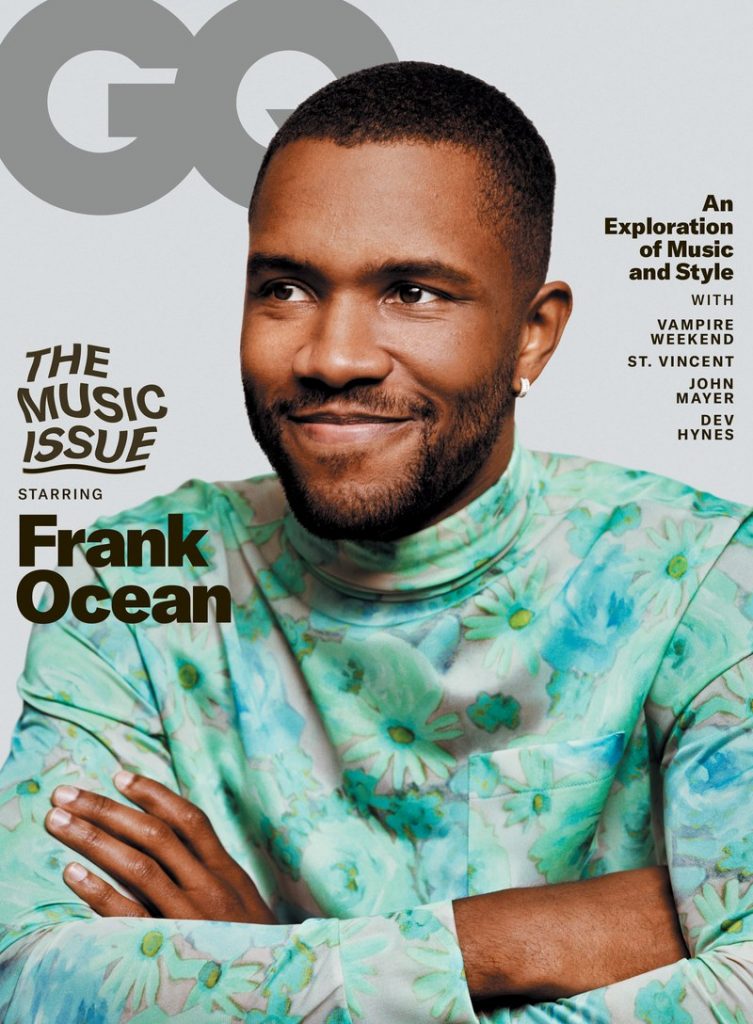
You can hear Welch’s personality come through GQ Style’s Corporate Lunch podcast, which he co-hosts with Noah Johnson. Welch isn’t afraid to assert an opinion, but while he splits his time with Johnson on the podcast, he also often seems like he’s more interested in hearing what others have to say instead of dictating what he thinks is good. He rarely talks bad about brands or certain fashions, instead preferring to comment on what he finds exciting. He speaks with a lot of slang, but without the air of in-group exclusivity that makes you feel like you should be sitting at another table. He generally just seems excited about the world and eager to learn more.
This sense of openness and optimism defines his editorial work. Chantal Fernandez at Business of Fashion said “his sense of stylishness can encompass everything from vintage Japanese sports cars to psychedelic Scandinavian sweaters.” When it comes to how he’ll change GQ, Welch is more interested in highlighting the diversity in dress and all the cool happenings in style-related culture, rather than writing about what men should wear (the kind of service journalism that touches on how to dress will continue at GQ.com). In a Business of Fashion interview, he said:
Instead of dictating what’s good and what’s bad from some sort of imaginary mountaintop, if we can be meaningfully participating in a community of people […] helping to elevate and tell the stories of the people who we think are doing stuff that is really exciting and that is something to believe in, to me that is a higher calling than, ‘Don’t wear those pants, wear these pants.’
In some ways, Esquire’s editor Jay Fielden is the opposite of that kind of figure. In interviews, he likes to remind people that he was born on a West Texas oil patch (his grandfather owned an oil company). “I’m not ashamed of it or trying to hide that I’m a descendant of cowboys and roughnecks, not Mayflower bluebloods,” he once told The Observer. But Fielden also doesn’t mind the trappings of blue blood life, either. He went to Boston University to study Milton, a gentlemanly pursuit that presumably prepares one for a rarified career in publishing. His Instagram looks like a photo collage of the once idealized Esquire man, which is to say the sort of high-society life that peaked sometime around the 1960s — photos abound of expensive vintage cars and rare Rolexes, him boating somewhere in southern Europe, him playing golf and tennis, and generally all things swank.
Before heading Esquire, Fielden went through Manhattan’s publishing circuit. He was the Editor-in-Chief at Town & Country for five years, where he worked to transform the publication from “a slim portfolio of Midwestern debutante parties and East Coast WASP weddings, to a Vanity Fair manqué, a sassy primer to the good life with a bit of meat thrown in.” And before that, he was an Arts Editor at Vogue and, briefly, at the helm of Men’s Vogue before the publication folded in 2008. “I was taught to parse sentences by Eustace Tilley,” he told The New York Times, “and everything else by Anna Wintour.” The Times said that he edited Men’s Vogue “with a taste for Kiton suits, rare Scotch, and Hinckley yachts.”
Unlike Welch, Fielden doesn’t seem to have much interest in streetwear or popular culture — at times, he almost seems a bit disdainful of that world. He’s rarely seen wearing anything less than a two-piece suit, dark tie, and white pocket square. When he’s in casualwear, it’s in the sort of plush suede jackets you might find at Loro Piana or Cucinelli. Last year, when he served on the panel at a New York symposium, he was asked how he feels about men dressing down. “Many minefields for me to walk here,” he said hesitantly. Fielden then pulled out Pete Davidson, frequently heralded as a street style icon today, as an example of the sort of “random ugliness and lack of thoughtfulness” that he dislikes. (He did say, however, that he likes Supreme and Virgil Abloh, although less-than convincingly).
The main thing that separates Fielden from Welch is his willingness to jump into politics on social media. Welch continues the long tradition of editors being fairly private and elusive figures — his Instagram and Twitter accounts are mostly reserved for promoting his publication’s work. Fielden similarly uses social media to promote Esquire’s stories, but he also engages in politics. It would be wrong to characterize him as purely conservative or liberal, but his social media has a running theme of frustration with the academic and far left. He tweets about how socialism leads to mass murder, “the apparatchiks of high academic PC goofballery,” and the “sanctimonious thought police.” His “likes” page includes tweets about “cancel culture,” the liberal media, and how “intersectional rhetoric is driven by affluent, older white men in the media who are crippled by guilt and an insatiable need to curry favor with female Millennials who work in their milieu.” (Welch, by contrast, mostly likes tweets about pop culture, streetwear, and fashion).
Fielden has been Esquire’s Editor-in-Chief for three years now. During that time, he’s pushed for politically charged stories — a profile on Jordan Peterson, an examination on how many Texans want a wall along the southern US border, and an article on “the fucking P.C. culture problem.” In a letter to his readers last year, Fielden tried to tackle the gun control debate. “This isn’t just a gun issue, for instance — it’s evidence of a mental-health crisis,” he wrote. “Let me add one more unpopular and perplexing question: What might our eerie pop-culture obsession with bloodthirsty video games and movies have to do with mass shootings? These things might not encourage people to kill other people, but they certainly don’t encourage them not to.” And when a senior editor proposed the idea of profiling what it’s like growing up as a white, male conservative in today’s age, Fielden turned it into this month’s cover story.
Men’s style magazines are struggling. A year before Fielden was handed Esquire, Condé Nast shuttered Details, letting go of most of its staff. GQ, while not in financial crisis, has lost a lot of its cultural relevancy. Welch and Fielden are trying to save the two biggest titles, both legacies of Apparel Arts, but have dramatically different approaches that reflect their contrasting personalities. GQ, moving forward, will likely be more open-minded and engaged with culture — “the only place to go when you want a rich, intelligent, and transportive plunge into all the stylishness the world has to offer,” Welch writes in the opening salvo of his first issue as Editor-in-Chief. Esquire, on the other hand, seems to be increasingly politicized, at times with the sort politics that reflects Fielden’s frustrations with a changing world. Whether either approach will resonate with enough men to pull up subscription numbers is anyone’s guess.







